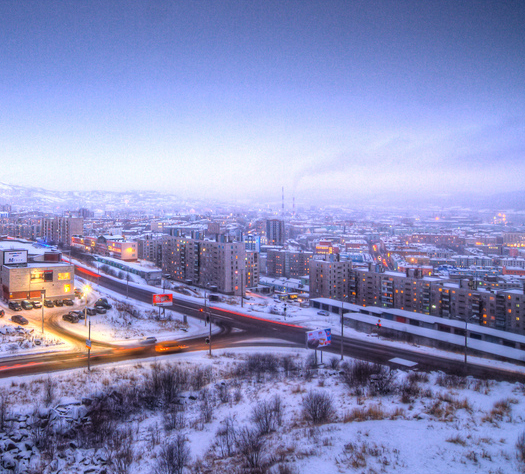
[Murmansk in polar night, photographed by flickr user euno.]
The Wall Street Journal recently ran a fascinating excerpt from geoscientist Laurence Smith’s new book, The World in 2050, which looks at how four global “megatrends” — “human population growth and migration; growing demand for control over such natural resource ‘services’ as photosynthesis and bee pollination; globalization; and climate change” — are fueling both international involvement and urban growth in the Arctic:
Much of the planet’s northern quarter of latitude, including the Arctic, is poised to undergo tremendous transformation over the next century. As a booming population increases the demand for the Earth’s natural resources, and as lands closer to the equator face the prospect of rising water demand, droughts and other likely changes, the prominence of northern countries will rise along with their projected milder winters…
[In 2050, this] New North… might be something like America in 1803, just after the Louisiana Purchase from France. It, too, possessed major cities fueled by foreign immigration, with a vast, inhospitable frontier distant from the major urban cores. Its deserts, like Arctic tundra, were harsh, dangerous and ecologically fragile. It, too, had rich resource endowments of metals and hydrocarbons. It, too, was not really an empty frontier but already occupied by indigenous peoples who had been living there for millennia.
Flying over the American West today, one still sees landscapes that are barren and sparsely populated. Its towns and cities are relatively few, scattered across miles of empty desert. Yet its population is growing, its cities like Phoenix and Salt Lake and Las Vegas humming economic forces with cultural and political significance. This is how I imagine the coming human expansion in the New North. We’re not all about to move there, but it will integrate with the rest of the world in some very important ways.
I imagine the high Arctic, in particular, will be rather like Nevada—a landscape nearly empty but with fast-growing towns. Its prime socioeconomic role in the 21st century will not be homestead haven but economic engine, shoveling gas, oil, minerals and fish into the gaping global maw.
Read the full article at the Wall Street Journal.

